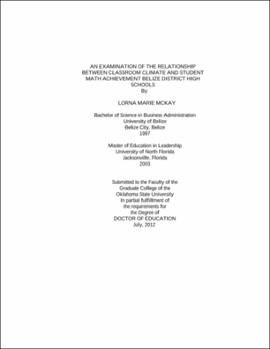| dc.contributor.advisor | Harris, Ed | |
| dc.contributor.author | McKay, Lorna Marie | |
| dc.date.accessioned | 2013-11-26T08:33:25Z | |
| dc.date.available | 2013-11-26T08:33:25Z | |
| dc.date.issued | 2012-07 | |
| dc.identifier.uri | https://hdl.handle.net/11244/7257 | |
| dc.description.abstract | Scope and Method of Study: | |
| dc.description.abstract | In the study, the sample consisted of 18 high schools and 477 students from ninth grade or first form who sat the BPSE in 2011. The population came from the Belize District schools of 2700 students that provided a randomly selected sample of 540 study participants. The researcher used a Learning Environment Inventory (LEI) by (Fraser, 1992) to collect data on classroom climate and the Belize Primary School Examination (BPSE) for 2011 in order to obtain students' mathematics scores. The study was correlation. | |
| dc.description.abstract | The purpose of the study was to examine the relationship that exist classroom climate and student math achievement. The study also sought to determine the classroom climate variables that affect student math achievement. The majority of learning environments assessments is based on students' perceptions. Students' and teacher perceptions of the learning environment could give valuable information to improve the quality of learning and can evaluate the innovation in education (Fraser, 1998). From the literature reviewed and the findings from this study, the researcher concludes that: (1). the independent variable, school type is statistically significant to student math achievement scores; (2). the independent variable, gender is not statistically significant to student mathematics performance and, (3). the other climate variables contribute very little to influence students' math scores on PSE. | |
| dc.description.abstract | Findings and Conclusions: The results of study indicated that with regard to the relationship between PSE math achievement scores and the continuous independent climate variables (i.e. personalization, involvement, student cohesiveness, satisfaction, task orientation, innovation, and individualization) there were weak positive correlations between the PSE math achievement scores and specific classroom climate variable such as student cohesiveness, task orientation, personalization, involvement, and satisfaction. Also there were weak negative correlations between the PSE math achievement scores and innovation and individualization. The weak correlations between PSE and aforementioned continuous independent variables implied that there may be increases or decreases in PSE math achievement. Thus, with the exception of school type each independent variable contributed very little of information about the PSE math achievement scores. | |
| dc.format | application/pdf | |
| dc.language | en_US | |
| dc.rights | Copyright is held by the author who has granted the Oklahoma State University Library the non-exclusive right to share this material in its institutional repository. Contact Digital Library Services at lib-dls@okstate.edu or 405-744-9161 for the permission policy on the use, reproduction or distribution of this material. | |
| dc.title | Examination of the relationship between classroom climate and student math achievement Belize District high schools | |
| dc.contributor.committeeMember | Krumm, Bernita | |
| dc.contributor.committeeMember | Wanger, Steve | |
| dc.contributor.committeeMember | McCharen, Belinda | |
| osu.filename | McKay_okstate_0664D_12219.pdf | |
| osu.accesstype | Open Access | |
| dc.type.genre | Dissertation | |
| dc.type.material | Text | |
| dc.subject.keywords | achievement | |
| dc.subject.keywords | classroom climate | |
| dc.subject.keywords | high school | |
| dc.subject.keywords | mathematics | |
| dc.subject.keywords | primary school examination | |
| dc.subject.keywords | relationship | |
| thesis.degree.discipline | Higher Education | |
| thesis.degree.grantor | Oklahoma State University | |
